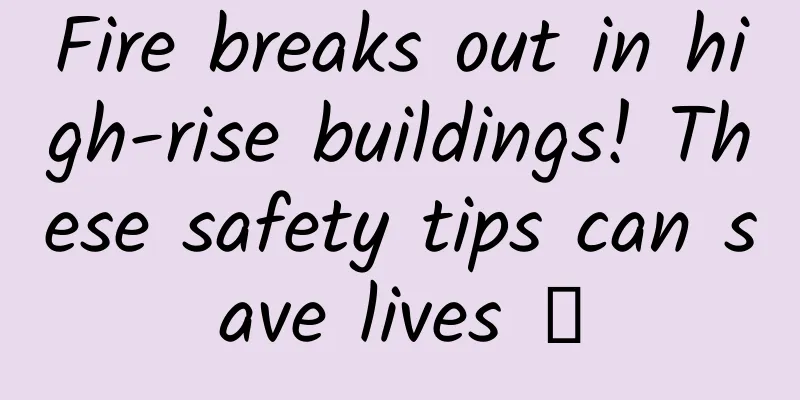Fire breaks out in high-rise buildings! These safety tips can save lives →

|
December 11 Notice from Shenzhen Fire Rescue Detachment That afternoon Phase II of Yuefu, Yuehai Street, Nanshan District Fire broke out in residential building 1 As of 18:00 on the day The fire at the scene has been successfully extinguished The accident resulted in one death The cause of the accident is under further investigation A fire broke out in Building 1 of the second phase of Yuefu, Yuehai Street, Nanshan District Image source: Emergency Management Online In recent years Fires in high-rise buildings occur frequently Plus it’s winter Increased consumption of fire, electricity and gas Fire hazards increase So what are the common causes of fires in high-rise buildings? How to escape correctly when encountering a fire? Dr. Ko will take you to find out! With the acceleration of urbanization, high-rise buildings are becoming more common. However, the fire safety issues of high-rise buildings are becoming increasingly prominent. Once a fire accident occurs, rescue and escape face huge challenges due to the particularity of its structure. There are several common causes of high-rise building fires: The fire safety risks in high-rise buildings are different from those in ordinary building fires. The main hidden dangers are difficulty in extinguishing fires, multiple business types, rapid spread, and difficulty in evacuation . (1) Difficult to rescue Taking into account factors such as the climbing surface, working surface, and weather conditions, the effective rescue height of ordinary fire trucks is only more than 50 meters. (2) Multiple business formats There are many types of places in high-rise buildings with complex business types. These places often have problems such as unclear fire responsibilities and lack of safety management, resulting in "each place is responsible for an area and there is no connection with each other", which can easily miss the best time to report the incident to the police for rescue. (3) Fast spread High-rise buildings have large fire loads and many pipeline shafts of various types. From the actual situation of fire investigation, smoke can often fill the entire space in about 3 minutes. The “Chimney Effect” of High-Rise Buildings The "chimney effect" refers to the phenomenon that indoor air rises or falls along the vertical slope of the space, causing the air to strengthen convection. After a fire occurs in a high-rise building, smoke spreads vertically at a speed of 3-4m/s through stairwells, pipe wells, glass curtain wall gaps and other parts, which can quickly ignite the entire building. Image source: Nanning Fire Department (4) Slow evacuation High-rise buildings have many floors, many people, and long vertical distances, so evacuating people is time-consuming and difficult. High-rise buildings, with their complex functional layout, dense flow of people, and the use of many flammable materials, often lead to serious consequences and huge losses once a fire occurs. Therefore, for the fire prevention work of high-rise buildings , we must start from the little things in our daily life to prevent it before it happens. (1) Do a good job in "three clearances and three checks" ① “Three Purities” Clean the kitchen. The kitchen is where the most fire is used in the home. The key to cleaning the kitchen is to keep combustibles such as oil, paper, and cloth away from fire sources such as stoves. Clean the balcony. Clean up the debris on the balcony in time, especially flammable items such as cartons, cardboard, and plastic. When you are out for a long time, close the doors and windows to prevent sparks from flying into the house and causing a fire. Clear the corridors. Do not pile up debris in corridors, stair corners, basements, etc.; electric vehicles should not be charged in stairwells, evacuation passages, or emergency exits. Keep fire passages and emergency exits clear. ②Three Gates Turn off the gas. Turn off the gas source in time after using the gas, do not change the gas pipeline without authorization, and regularly check the gas hose for aging, falling off, leakage and other household fire hazards. Turn off the power. While various household appliances bring convenience to residents, they also have certain hidden dangers. Residents must pay attention to the time and method of use, and turn off the power in time when not in use. Close doors and windows. Check whether there are any debris piled up at the staircases and balconies in your home. It is best not to install fence-type anti-theft windows to prevent difficulties in escaping after a fire accident. (2) The “life channel” must be unobstructed ① It is strictly prohibited for private cars, electric vehicles, fixed obstacles, etc. to occupy or block the passage of fire trucks. ② It is strictly prohibited to pile up sundries in the evacuation corridors (hallways, stairwells, corridors, etc.) and emergency exits of residential unit buildings. ③ It is strictly forbidden to block or lock the emergency exit to ensure smooth passage. (3) Strengthen daily management ①Carry out centralized renovation of the public areas in the lobby of each unit to ensure the smooth flow of fire safety passages. ② Conduct a unified and thorough inspection of the electrical equipment in the electrical wells in the lobby of each unit to ensure the normal and safe operation of the equipment and prevent the occurrence of electrical fires. ③ Strengthen fire supervision and management, carry out fire protection knowledge publicity in the community, organize fire drills and training from time to time, and enhance the fire safety awareness and prevention and self-rescue capabilities of all personnel. ④ When a fire occurs, the property service unit staff must provide guidance for fire rescue vehicles and promptly clear obstacles at the door to ensure that the fire trucks can enter. (4) Always have at home What fire protection equipment? ① Self-rescue respirator: can effectively filter smoke. ② Portable fire extinguishers and fire blankets: Fire extinguishers and fire blankets can be used to put out early fires. Once a fire occurs, you can also cover yourself with a fire blanket to provide some isolation and protection. ③High-intensity flashlight: It is convenient for escaping at night and can also be used to send out distress signals. (1) If the fire occurs upstairs You should quickly go downstairs through the evacuation stairwell . During the escape, you can carry a wet towel or clothing to cover your mouth and nose to reduce the damage of smoke to your respiratory tract. (2) If the fire comes from the same floor or downstairs And there is smoke infiltration at the entrance door If you are sure that the fire and smoke are coming from the same floor or below , do not open the door and run away hastily. You should first touch the door handle and observe the gap at the bottom of the door. If the door handle is hot and smoke seeps into the gap, it means that the outside has been blocked by smoke. Do not open the door blindly to escape at this time, because the toxic smoke will make people faint and suffocate to death. Dangers of thick smoke ①The main cause of death from thick smoke is carbon monoxide poisoning. In air with a carbon monoxide concentration of 1.3%, a person will lose consciousness after taking two or three puffs of smoke, which may lead to death within minutes. The carbon monoxide content in the smoke produced by the burning of commonly used building materials is as high as 2.5%. ② Inhalation injury: refers to the damage to the respiratory tract and lung parenchyma caused by the inhalation of certain chemical components in hot air, steam, smoke, harmful gases, and volatile chemicals by the human body, as well as systemic chemical poisoning caused by the inhalation of toxic gases and substances. If you encounter thick smoke at the fire scene, you can use a wet towel or clothing to block the door gap to reduce the entry of smoke, call 119 to inform the location of the room you are trapped in, and wait for rescue. At the same time, keep watering the entrance door to prevent the high temperature outside from baking and spreading the fire. (3) If the fire comes from the same floor or downstairs There is no obvious smoke in the stairwell If you find that there is no obvious smoke in the evacuation stairwell, you should go downstairs as soon as possible. Attention! When passing through the normally closed fire door, you should close the door and avoid being greedy for property and delaying the escape opportunity. (4) Early stages of fire When the fire first starts, the smoke fills the top of the ceiling, but has not yet sunk to threaten people's normal breathing. At this time, you can walk upright and quickly choose a safe exit with less traffic and a closer location to escape. Bending down blindly or even crawling to escape will reduce your visual range, accelerate physical exhaustion, and reduce the speed of evacuation. (5) In the middle of the fire When the surrounding area is filled with thick smoke and the smoke has threatened people's mouths and noses, you must choose to evacuate by bending down. This is because high temperature will cause smoke to accumulate in the upper space, and the closer to the ground, the fresher the air, which is more conducive to our evacuation. (6) When you cannot escape How to avoid risks? When choosing a hiding place, try to select a room on the outside of a building close to the main street and with openable windows. Dial 119 as soon as possible and provide as clear and specific information as possible. You can make noises or light or wave clothes at the window to call for help. (7) Three Don'ts for Escape from High-Rise Buildings ①Don’t take the elevator When escaping from a fire scene, follow the escape route marked with "Safety Exit". When escaping from a high-rise building, use the stairs and never use the elevator. ②Don’t open the door blindly Before opening the door, touch the door or door lock lightly with the back of your hand. If it is already hot, or smoke is flowing into the door gap, it means that the fire or smoke has blocked the door. Do not open the door easily at this time. You can use towels or quilts to block the door gap, and pour water to cool it down. ③Don’t jump off the building blindly Never jump off a building blindly unless the fire rescue personnel are fully prepared for the rescue. Fire is merciless Prevention First Let’s start with ourselves Start small Enhance fire safety awareness Strengthen fire prevention measures Build a high wall of fire prevention with action This is the end of this issue Want to see more interesting and practical content Follow me now Source: Emergency Management Online, China Fire, Shenyang Emergency, National Emergency Broadcasting. The cover image and images within this article are from the copyright gallery Chuangke Post. Any reproduction or use may lead to copyright disputes. For original images and texts, please reply “reprint” in the backstage. |
<<: Polyphenols in pears, a healthy “antidote” to high-fat foods?
Recommend
How does the modern "Kuafu" satellite chase the sun?
Produced by: Science Popularization China Author:...
A new methodology for brand creativity!
To be frank, after more than ten years of working...
Xiaohongshu product analysis report!
Xiaohongshu is known as a popular shopping tool f...
There is no thunder on typhoon days. Are these two things "incompatible"?
Audit expert: Zhan Mingjin PhD, Chinese Academy o...
Toyota considers acquiring technology companies to ensure autonomous driving
Toyota Motor President Akio Toyoda said on Wednes...
Android screenshots and WebView long pictures sharing experience summary
While working on new business needs recently, we ...
Can the area with frostbite be soaked in hot water? Here comes the list of scientific rumors in January →
1. Can the areas with frostbite be soaked in hot ...
How to fix PC game lag issues? Try these tips
Many friends like to play games on their computer...
Jixi watch mini program agent price inquiry, how much is the Jixi watch mini program agent price?
How much does it cost to be a Jixi agent for a wa...
Atushi SEO Training: Exposing the reasons why search engines crack down on external link exchange platforms
Why search engines attack external link exchange ...
Why is the altitude of 10 kilometers chosen for reusable rocket tests?
(Picture from the Internet) Why do everyone choos...
How to explore user needs? Follow these 5 steps!
We are always asked to explore user needs. How do...
Things about online game advertising | Insights into information flow advertising data
Online game advertising has a special position in...
How to design new product invitation activities to promote products themselves (Part 2)
This article is a summary of the results of a use...
What is the difference between Tik Tok fans and following? What are the minefields in Douyin operations?
This article mainly introduces the difference bet...









